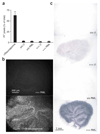A versatile prion replication assay in organotypic brain slices
- PMID: 18066056
- PMCID: PMC2754795
- DOI: 10.1038/nn2028
A versatile prion replication assay in organotypic brain slices
Abstract
Methods enabling prion replication ex vivo are important for advancing prion studies. However, few such technologies exist, and many prion strains are not amenable to them. Here we describe a prion organotypic slice culture assay (POSCA) that allows prion amplification and titration ex vivo under conditions that closely resemble intracerebral infection. Thirty-five days after contact with prions, mouse cerebellar slices had amplified the abnormal isoform of prion protein, PrP(Sc), >10(5)-fold. This is quantitatively similar to amplification in vivo, but fivefold faster. PrP(Sc) accumulated predominantly in the molecular layer, as in infected mice. The POSCA detected replication of prion strains from disparate sources, including bovines and ovines, with variable detection efficiency. Pharmacogenetic ablation of microglia from POSCA slices led to a 15-fold increase in prion titers and PrP(Sc) concentrations over those in microglia-containing slices, as well as an increase in susceptibility to infection. This suggests that the extensive microglial activation accompanying prion diseases represents an efficacious defensive reaction.
Figures





Similar articles
-
Engulfment of cerebral apoptotic bodies controls the course of prion disease in a mouse strain-dependent manner.J Exp Med. 2010 Sep 27;207(10):2271-81. doi: 10.1084/jem.20092401. Epub 2010 Sep 13. J Exp Med. 2010. PMID: 20837697 Free PMC article.
-
The prion organotypic slice culture assay--POSCA.Nat Protoc. 2008;3(4):555-62. doi: 10.1038/nprot.2008.13. Nat Protoc. 2008. PMID: 18388937
-
Flow Cytometric Detection of PrPSc in Neurons and Glial Cells from Prion-Infected Mouse Brains.J Virol. 2017 Dec 14;92(1):e01457-17. doi: 10.1128/JVI.01457-17. Print 2018 Jan 1. J Virol. 2017. PMID: 29046463 Free PMC article.
-
[Mechanisms of prion transmission].Nihon Rinsho. 2007 Aug;65(8):1391-5. Nihon Rinsho. 2007. PMID: 17695274 Review. Japanese.
-
Transgenic models of prion disease.Arch Virol Suppl. 2000;(16):113-24. doi: 10.1007/978-3-7091-6308-5_10. Arch Virol Suppl. 2000. PMID: 11214913 Review.
Cited by
-
Prion propagation, toxicity and degradation.Nat Neurosci. 2012 Jun 26;15(7):936-9. doi: 10.1038/nn.3120. Nat Neurosci. 2012. PMID: 22735515 Review.
-
Engulfment of cerebral apoptotic bodies controls the course of prion disease in a mouse strain-dependent manner.J Exp Med. 2010 Sep 27;207(10):2271-81. doi: 10.1084/jem.20092401. Epub 2010 Sep 13. J Exp Med. 2010. PMID: 20837697 Free PMC article.
-
Accelerated prion replication in, but prolonged survival times of, prion-infected CXCR3-/- mice.J Virol. 2008 Dec;82(24):12464-71. doi: 10.1128/JVI.01371-08. Epub 2008 Oct 8. J Virol. 2008. PMID: 18842729 Free PMC article.
-
The Role of Microglia in Prion Diseases: A Paradigm of Functional Diversity.Front Aging Neurosci. 2017 Jun 23;9:207. doi: 10.3389/fnagi.2017.00207. eCollection 2017. Front Aging Neurosci. 2017. PMID: 28690540 Free PMC article. Review.
-
Polythiophenes inhibit prion propagation by stabilizing prion protein (PrP) aggregates.J Biol Chem. 2012 Jun 1;287(23):18872-87. doi: 10.1074/jbc.M112.355958. Epub 2012 Apr 6. J Biol Chem. 2012. PMID: 22493452 Free PMC article.
References
-
- Aguzzi A, Polymenidou M. Mammalian prion biology. One century of evolving concepts. Cell. 2004;116:313–327. - PubMed
-
- Büeler H, et al. Mice devoid of PrP are resistant to scrapie. Cell. 1993;73:1339–1347. - PubMed
-
- Prusiner SB, et al. Measurement of the scrapie agent using an incubation time interval assay. Ann. Neurol. 1982;11:353–358. - PubMed
-
- Solassol J, Crozet C, Lehmann S. Prion propagation in cultured cells. Br. Med. Bull. 2003;66:87–97. - PubMed
Publication types
MeSH terms
Substances
Grants and funding
LinkOut - more resources
Full Text Sources
Molecular Biology Databases
Research Materials

